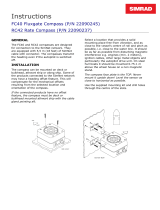
12 Installation
The most important factor in the performance of any
AIS transceiver will be the quality and positioning of the
antenna.
As the range of VHF signals are governed by line of sight,
the antenna should be placed as high as possible, while
remaining clear of any metallic objects.
Long whip antennas are generally recommended for
larger boats, although the most popular antennas for
marine use is 1m (3ft 3in) long. On sailboats these are
usually mounted on the masthead, where the length of
the antenna keeps it clear from the navigation lights and
wind vanes. This type of antenna can also be mounted on
the cockpit roof or powerboat garages.
For maximum range, it is recommended that a VHF antenna
specifically tuned for use with an AIS is used, and mounted
away from the standard VHF antenna. Vertical separation is
preferred, but where this is not practical, at least 5 metre
horizontal spacing is recommended
The antenna coaxial cable and any connectors used
must be rated at 50Ω. Under no circumstances
should standard domestic TV cable and connectors
be used. Incorrectly rated cabling and connectors
could result in power not reaching the antenna, but
also power could be reected back into the NAIS-
300 unit, reducing its performance.
The quality of any connections and integrity of the
cable will directly affect the performance of the radio.
Poor soldering or corrosion of the terminals can impair
performance. We recommend that screw or crimp
terminal type connectors are not used for any through
deck fittings - a good quality waterproof solder terminal
connector will be less susceptible to poor connection due
to corrosion of the contacts.
To ensure the best performance of the radio, the antenna
cable should be routed where it is least likely to interfere
with, or receive interference from other electronic
equipment, such as echo sounder transducer cables and
high current carrying cables.
























